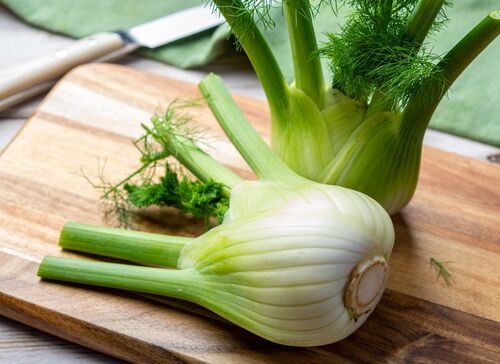Fennel Sowing and Growing

Fennel belongs to the umbelliferous family. There are two types: the bulb producing fennel, the bulb is formed by the lower, thickened parts of the leaves, and the leaf producing fennel. The cultivation method is the same for both species and both fennel varieties have an anise-like taste. It is a versatile plant; the bulb is used as a vegetable, the leaf as a herb and the seeds as a spice.
Growing your own fennel from seeds
Fennel can be sown at several times of the year. This makes it possible to spread the harvest and eat fresh fennel from the garden until October. There are two varieties, namely bulb fennel and leaf fennel. The first is grown for the bulb, which can be eaten as a vegetable. The second for the leaves and seeds, which is used as a herb or spice. It becomes a sizable plant, with lots of foliage, so they need a lot of space. The plant also looks nice in borders, among other flowers. Certain insects, such as mosquitoes and moths, do not like the smell of fennel. Fennel requires little care and is easy to grow.
Sowing and planting fennel
Fennel can be sown at different times. For an early harvest, sowing in a greenhouse or indoors can be done in March and April, after which the plants can be planted out in the open in April and May. Harvesting can then be done from July to September.
In May, sowing can be done in the open ground, after which harvesting can also be done from July to September. For a later harvest, around October, sowing in the open ground can be done from mid-June to mid-July.
Sowing fennel very early or very late prevents them from bolting in summer. Ensure adequate planting distances, about 20 to 30 cm between plants and 30 x 40 cm between rows, to give the plants enough space to develop.
Position and soil
Fennel likes a sunny spot in the garden. The soil should be slightly moist and well-drained. In addition, the soil must contain sufficient nutrients. Add compost to the soil before sowing or transplanting and make sure the soil is loose.
How to care for your fennel plants
The care of fennel is not difficult. Keep the soil around the plant weed-free and water it in warm, dry weather. Fennel needs some extra nutrition during growth, use a fertiliser that contains extra potassium.
When and how to harvest fennel?
Fennel can be harvested from July into October, depending on when it was sown.
Using a sharp knife, cut off the bulb just above the roots. The leaves can be used as a herb.
Leaf fennel can be harvested throughout the growing season if the stalks and leaves are large enough. Do leave some leaves on the plant so that it can continue to grow.
To harvest seeds, the plant must have flowered. This is possible with both leaf and bulb fennel. The flower heads can be harvested in October, when they have dried out.
How to preserve fennel
Root single can be stored for several days in the vegetable drawer of the refrigerator. Outside the refrigerator, fennel spoils quickly. The vegetable can also be frozen. Clean first and blanch if necessary. The leaves can also be kept in the refrigerator for several days. If necessary, the leaf can also be dried. It does lose some of its flavour. The harvested umbellifers must first dry further. Put these in a paper bag, when they are dry the seeds can be shaken off. Store the seeds in a dry place.
Is fennel healthy?
Fennel is healthy and contains a lot of vitamin C and folic acid (vitamin B11). Fennel also contains other types of vitamins and potassium, calcium, iron, magnesium and phosphorus. Medicinal effects attributed to fennel include: promoting digestion, stimulating milk production during breastfeeding and suppress hunger.
Fennel seeds in our collection
In our range we have different types of fennel, including an organic variant.
Tips for sowing fennel
Fennel can be pre-sown in the spring, but unlike other seedlings, place it in a somewhat cooler, light spot. This is to prevent bolting later in the season.



